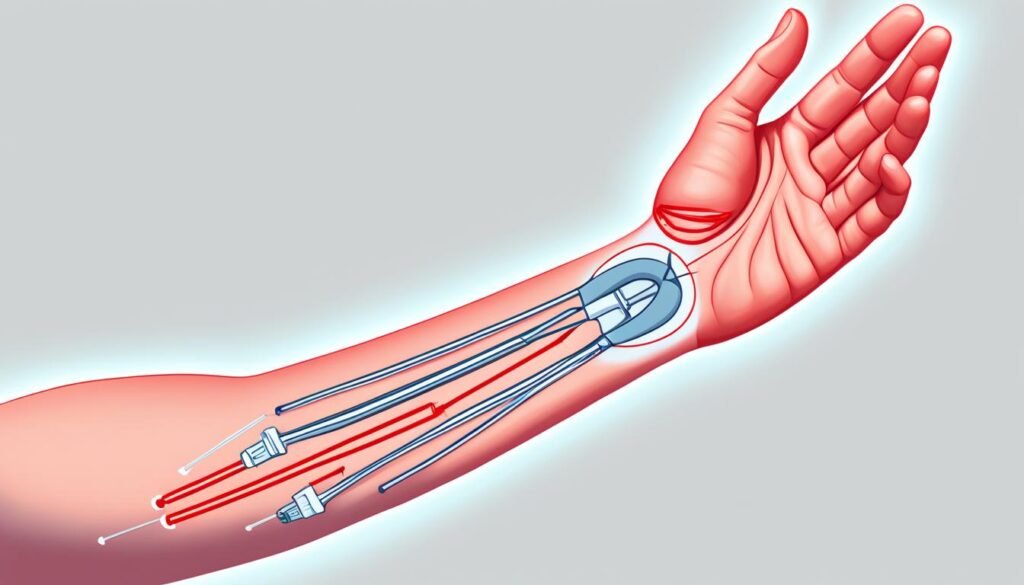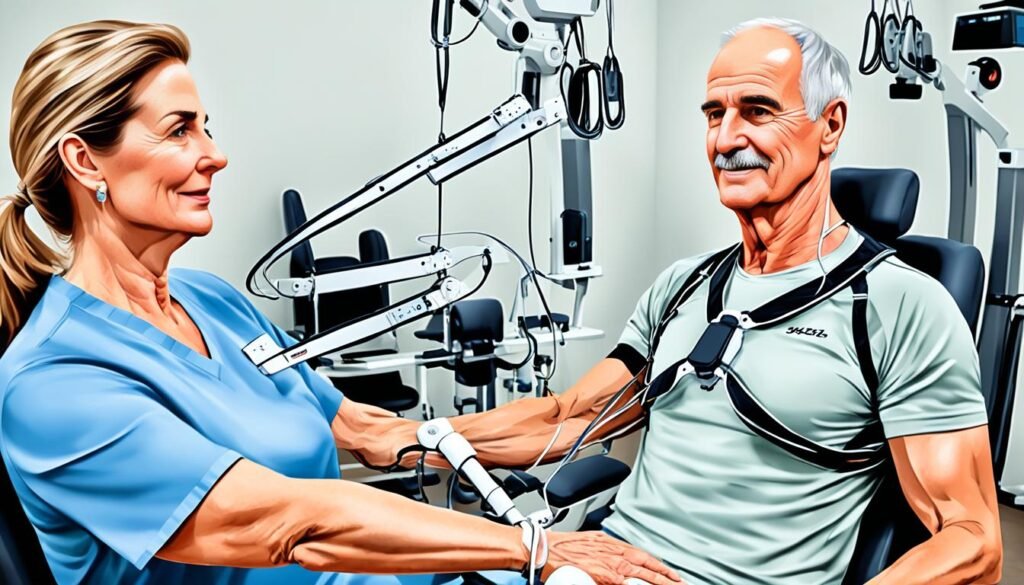Are you or a loved one dealing with radial nerve palsy (RNP)? This condition makes grip strength drop by 77%.
But, there’s hope with modern treatments for radial nerve palsy treatment can bring back function and movement. Early and smart radial nerve palsy treatment is key to healing and recovery.
In this blog, we’ll look at what causes radial nerve palsy, how to spot it, and what modern treatments can help you recover safely and fully.
Table of Contents
ToggleUnderstanding Radial Nerve Palsy
Radial nerve palsy (RNP) happens when the radial nerve gets damaged. This nerve runs down the back of your arm. It controls the muscles that straighten your elbow, wrist, and fingers.
When the nerve is damaged, these muscles don’t work right. It also reduces grip strength by up to 77%. This leads to weakness, numbness, or a dropped wrist.
Causes and Risk Factors
Many things can cause radial nerve palsy. Some are common accidents. Others are hidden health problems:
- Direct injury from broken bones, especially a humerus fracture
- Long pressure on the arm, like sleeping with your arm hanging (Saturday night palsy)
- Repetitive stress or overuse of the arm
- Health issues like diabetes or tumors pressing on the nerve
- Systemic conditions such as infections or autoimmune diseases
Common Symptoms to Recognize
You can usually tell something is wrong by how your hand and arm feel and move:
- Drooping of the wrist (wrist drop)
- Difficulty straightening fingers or wrist
- Weak grip strength
- Numbness on the back of the hand and forearm

Diagnosis and Evaluation
It’s crucial to correctly diagnose radial nerve palsy (RNP) to treat it effectively. Doctors use a detailed physical exam, imaging tests, and electrodiagnostic studies for this. These steps are vital in creating a plan that works for you.
A neurologist like Dr. Chandril Chugh will run several tests to confirm the diagnosis:
- Physical exam to test strength and reflexes
- EMG testing (electromyography) to check nerve signals
- Nerve conduction studies to see how fast your nerves send signals
Early diagnosis helps avoid long-term damage and improves results.

Non-Surgical Radial Nerve Palsy Treatment Options
In the start, if you have radial nerve palsy, radial nerve palsy treatment using splints and braces can be key in getting better. They stop your muscles from getting too tight and keep your joints moving well.
Splinting and Bracing
Your doctor might suggest wearing a splint or brace for your wrist and fingers. This helps the irritated nerve to heal. It’s a good plan if your nerve isn’t badly hurt.
Physical Therapy and Exercises
Physical therapy and specific exercises also really help. They aim to get back your strength, keep muscles from locking up, and improve how well your hand works. Doing these together boosts your chances of getting fully better.

Radial Nerve Palsy Treatment Surgical Interventions
If there’s no progress after months, or the nerve is fully torn, surgery may be needed. The decision is based on tests and how long the symptoms last.
When Is Surgery Recommended?
Surgery is often advised when:
- There is zero recovery within 3 to 6 months
- EMG shows nerve is completely cut or detached
- Severe trauma caused full radial nerve injury
Common Surgical Procedures
Doctors choose the right procedure based on the nerve damage:
- Radial nerve repair surgery: Directly sewing the nerve ends back together
- Nerve grafting: When the nerve damage is severe, nerve grafting could be considered. This means creating a ‘bridge’ for the damaged nerve to heal. By using your own nerve tissue, it helps the nerve grow back and connect with your muscles again.
- Tendon transfers: For some non-recovering cases of RNP, tendon transfers may be the solution. A method like the modified Merle D’Aubigné can be used. It helps to move tendons in a way that allows your wrist and fingers to work properly again.
- Nerve decompression: Surgery may involve nerve decompression. It tries to reduce pressure on the radial nerve and help you recover. Doctors release any tight spots along the nerve, like scar tissue or bone problems.
Recovery Timeline After Surgery
Healing takes time. Most people regain function over months, not weeks.
| Post-Surgery Timeline | What to Expect |
|---|---|
| 1-3 Months | Pain control, light movement exercises begin |
| 3-6 Months | Strength starts to return, therapy becomes intensive |
| 6-12 Months | Fine motor control improves, daily use returns |
Success Rates and Outcomes
- Nerve graft recovery success: 40–60% for motor function
- Tendon transfer surgeries have a high success rate, often above 80%
Risks: Scar tissue, incomplete movement return, re-surgery in rare cases.

The Modified Merle D’Aubigné Tendon Transfer Method
The modified Merle D’Aubigné tendon transfer method helps patients regain wrist and finger movement. It’s for those with radial nerve palsy who haven’t seen improvement. This surgery uses updated muscle transfer techniques to get better results than before.
The surgery follows several important steps:
- Move the pronator teres muscle to the extensor radialis brevis to fix wrist extension.
- Switch the flexor carpi radialis muscle to the extensor digitorum communis and extensor pollicis longus for finger extension.
- Use the palmaris longus to help the thumb move better with the abductor pollicis longus and extensor pollicis brevis.
This method is a deep dive into fixing the challenges of radial nerve palsy. It offers better wrist and finger movement and overall hand function.
The outcome post-surgery is mainly positive for people with non-recovering RNP. Most patients report excellent or good results. This method can really make a difference, enhancing quality of life for these individuals.
Recovery and Rehabilitation
You may need tendon transfer surgery if you have non-recovering radial nerve palsy. After the surgery, you’ll need a period of rest followed by a rehab program. This program is key to gaining back strength, movement, and the use of your affected limb.
Post-Operative Care
In the beginning, you might have to wear a splint or cast to protect your surgery site. As you heal, your healthcare team will start you on exercises to move your limb. They will also begin other therapies to improve your function.
Occupational Therapy
Occupational therapy is very important for your recovery. Your therapist will help you get back to your usual daily activities and reach your full potential. They might teach you new skills, give you special tools, and show you how to solve any recovery hurdles.

Radial Nerve Palsy Treatment
Radial Nerve Palsy Treatment involves surgical methods to restore function and movement. One successful method is the modified Merle D’Aubigné tendon transfer. It helps patients move their wrists and fingers again.
Surgical Techniques
Doctors also perform nerve decompression and grafting, along with tendon transfers, to treat RNP. These surgeries aim to release pressure on the nerve and support nerve regrowth. This improves the chances of recovering function.
Nerve Repair Strategies
There are new therapies being developed to boost nerve healing. Innovations like nerve conduits and guidance channels show promise. They could improve outcomes for those with severe nerve injuries or cases where the nerve doesn’t heal.
Choosing the Right Treatment Path
Every patient’s needs are different. Picking the best radial nerve palsy treatment means understanding your case and getting the right help.
Finding the Right Specialist
You may need more than one expert:
- A neurologist (like Dr. Chandril Chugh) for nerve diagnosis
- An orthopedic surgeon for structural issues
- A physical or occupational therapist for recovery plans
Cost, Insurance, and Access
Understanding cost helps reduce stress:
- Surgery costs: $3,000–$12,000 in the U.S., cheaper in India
- Check if insurance covers nerve regeneration or rehab tools
- Many policies now cover radial nerve repair surgery and therapy
Prognosis and Outlook
The outlook for people with radial nerve palsy treatment depends on a few factors. This includes how bad the nerve injury is, what caused it, and how it’s treated. Many can get a lot of function back and go back to their usual life with the right care. It’s key to find it early and act fast for the best chance at a full recovery without lasting problems.
How long it takes to get better can change a lot. Most RNP cases improve in about 12 weeks with the first treatments. Younger people and those with just a small bit of nerve damage often do better. Yet, tough situations or when surgery is needed might mean healing takes six to eight months.
Noting the odds are good with proper care is important. Staying in touch with your medical team and sticking to a rehab plan can really help. This increases your chance of getting back most, if not all, of your movement and daily life.
Prevention and Risk Reduction
Radial nerve palsy (RNP) is tough, but you can lower the risk and avoid it. Focus on safety at work and use good plans to stop injury. This way, you cut down your chance of getting this serious nerve problem.
Workplace Safety
If you do tasks again and again, sit funny, or work in risky spots, think about your safety. Work with your boss for a better work setup. Use desks that move, seats that support well, and tools that are kind to your body. This stops too much pressure on you and lowers your RNP risk.
Injury Prevention Strategies
Other than safe work, there are steps to keep you from RNP and similar injuries. Lift things right, keep your back straight, and watch how you move, especially if you do things over and over or in odd ways. For sleeping, use pillows or supports to keep your body in a good balance. This helps stop pressure on your nerves when you sleep.
Even if you can’t stop all RNP cases, you can do a lot to lower your risk. Put safety first, and deal well with dangers at work. This means you are taking an important step in staying healthy and enjoying life.
Coping and Support
Navigating through radial nerve palsy (RNP) challenges can be tough. But, the right support and resources can help you overcome them. Educating yourself is key to empowering your recovery journey.
Patient Education
It’s important to know why you have RNP, its signs, and how it’s treated. Your healthcare team should share lots of information with you. This includes details on the condition and recovery steps using the modified Merle D’Aubigné tendon transfer method.
This knowledge turns you into a key player in your recovery. It gives you a sense of control and confidence.
Support Groups and Resources
Talking to others facing RNP can make a world of difference. Joining support groups offers many benefits. They give you people to share with, emotional support, and practical tips.
Also, look for resources and online communities. They can guide you through recovery and help tackle daily challenges with RNP.
Remember, you’re not on this journey alone. With the support and resources around you, staying positive becomes easier. It helps you work towards regaining your independence.
A Message from Dr. Chandril Chugh
Radial nerve palsy doesn’t have to stop you from living well. With smart care, early action, and expert guidance, recovery is real. The key is finding the right path, and sticking to it. If you or someone you know is dealing with wrist drop or sudden weakness, don’t wait. Book a consultation with me to explore the best radial nerve palsy treatment options.
If this condition happens because of a humeral shaft fracture, up to 94% of people see improvement right away. After surgery, about 89% of these cases get better. The chances of getting radial nerve palsy right from the start are around 10%, which drops to 3-7% after surgery. Most of these issues, about 88% to 100%, solve themselves in a few weeks to a few months.
People with radial nerve palsy often face injuries from low-energy trauma, like falls. Half of them have spiral fractures and nearly 90% have breaks in the middle part of their humeral shaft. Also, about 56% of these people are men, with a median age of 49. After an injury, 4.1% of patients end up with radial nerve palsy.
I’ve helped hundreds of patients regain movement, reduce pain, and feel in control again. You can, too.
FAQ
What is radial nerve palsy and what are its symptoms?
Radial nerve palsy (RNP) means you can’t fully open your wrist and fingers. This also makes your hand grip weaker. You might notice your wrist dropping and find it hard to extend your fingers. You could also feel less in the back of your hand.
What causes radial nerve palsy?
Humerus fractures, puncture wounds, and pressure on the nerve can cause radial nerve palsy.
How is radial nerve palsy diagnosed?
Doctors will do a physical exam to check for wrist drop and weak finger movement. They also look for lack of feeling on the back of the hand. X-rays and MRI scans might be done to find the cause. Nerve tests help see how bad the nerve damage is.
What are the non-surgical treatment options for radial nerve palsy?
Early on, using a splint can stop your hand from getting stiff. This makes sure your joints stay flexible. Physical therapy and exercises can keep your muscles strong and help you recover.
What are the surgical treatment options for radial nerve palsy?
If surgery is needed, options include fixing the nerve, grafting it, or moving tendons. The modified Merle D’Aubigné transfer helps get your wrist and fingers working better if the nerve won’t heal.
What is the modified Merle D’Aubigné tendon transfer method?
This method moves muscles in your arm to help extend your wrist and fingers. It improves on past methods and aims to fully restore movement.
What is the recovery and rehabilitation process like for radial nerve palsy patients?
After surgery, you’ll need time when you can’t move your hand. Then, you’ll start rehab to make your hand strong again. Occupational therapy is key to getting back to normal activities.
What is the prognosis for patients with radial nerve palsy?
How well you recover from radial nerve palsy depends on many factors. But, with the right care, most people can get a lot of their hand function back.
How can radial nerve palsy be prevented?
Be careful at work and learn how to avoid injuries. This can lower your chances of getting radial nerve palsy or other nerve problems.
What kind of support and resources are available for patients with radial nerve palsy?
Knowing about your condition and treatments can give you strength. Joining support groups or finding helpful resources can make your journey easier and more positive.
Source Links
- https://orthopedicreviews.openmedicalpublishing.org/article/94033-treatment-of-irrecoverable-radial-nerve-palsy-using-the-modified-merle-d-aubigne-tendon-transfer-method
- https://www.ncbi.nlm.nih.gov/pmc/articles/PMC8716365/
- https://www.healthline.com/health/radial-nerve-dysfunction
- https://www.ncbi.nlm.nih.gov/books/NBK537304/
- https://www.mountsinai.org/health-library/diseases-conditions/radial-nerve-dysfunction
About The Author

This article is medically reviewed by Dr. Chandril Chugh, Board-Certified Neurologist, providing expert insights and reliable health information.
Dr. Chandril Chugh is a U.S.-trained neurologist with over a decade of experience. Known for his compassionate care, he specializes in treating neurological conditions such as migraines, epilepsy, and Parkinson’s disease. Dr. Chugh is highly regarded for his patient-centered approach and dedication to providing personalized care.
→ Book a consultation to discover which remedies suit your needs best.




